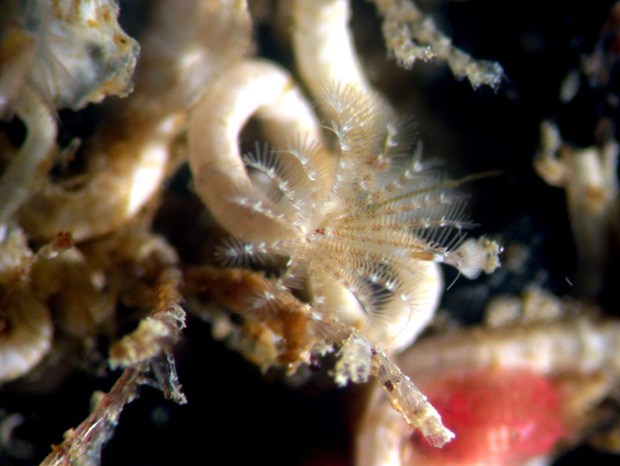How bacteria induce settling and transformation of marine larvae investigated
 A close-up image of the tubeworm Hydroides elegans with its feather-like tentacles extended from its tube. The tentacles both collect microscopic food particles from the water and serve as the place for gas exchange for the worm, passing carbon dioxide from the worm and gaining dissolved oxygen from the water. Image courtesy of Brian Nedved.
A close-up image of the tubeworm Hydroides elegans with its feather-like tentacles extended from its tube. The tentacles both collect microscopic food particles from the water and serve as the place for gas exchange for the worm, passing carbon dioxide from the worm and gaining dissolved oxygen from the water. Image courtesy of Brian Nedved.For more than 100 years, marine biologists have sought an understanding of how the minute larvae of marine invertebrate animals—cast out into the vast ocean—find and settle in the right ecological settings for survival, growth and reproduction. A grant, totaling more than $870,000, from the Gordon and Betty Moore Foundation to the University of Hawaiʻi will support research to understand the mechanisms by which marine biofilm bacteria—bacteria that live in slime films on the surfaces of all objects submerged in the sea—induce the settling of larvae of marine invertebrate animals.
With this grant, a UH research team will focus on a small tube worm, Hydroides elegans, that settles onto marine surfaces in warm ocean waters around the world where they form masses of hard, calcified tubes. The team, led by professor Michael Hadfield at the Kewalo Marine Laboratory (KML), Pacific Biosciences Research Center (PBRC), includes larval biologist Brian Nedved (KML), microbiologist Rosie Alegado (Daniel K. Inouye Center for Microbial Oceanography: Research and Education, Department of Oceanography, and Sea Grant) and natural products chemist Shugeng Cao (Department of Pharmaceutical Sciences, Daniel K. Inouye College of Pharmacy, UH Hilo).
In the last two decades there has been growing recognition that bacteria are likely the factor that causes many free-floating larvae to settle and transform, yet very little is known of the diversity of bacteria that stimulate larvae to settle and less is known of the mechanisms through which these bacteria act.
Read more about it in the UH System News.



